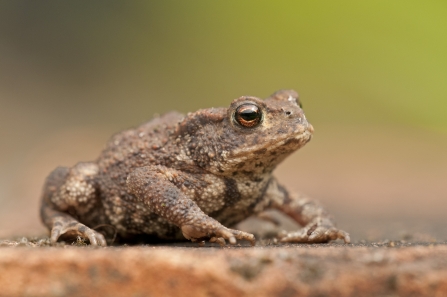
Credit: Mark Hamblin/2020VISION
Fantastic Frogs & Tantalising Toads

Credit: Katrina Martin/2020VISION
The 20th century saw huge losses of ponds to development and changes in farming practices, sites vital to the survival of amphibians. The saviour of the common frog and toad has been the increase in the number of garden ponds, toad has been the increase in the number of garden ponds, providing an artificial alternative to these lost wildlife habitats.

Credit: Dawn Monrose
Spotting the difference
The most obvious difference between these two amphibians is their skin. Frogs have moist smooth skin, greenish brown to yellow in colour, with a distinctive brown patch behind the eye; while toads have drier bumpy skin, which is often brownish. The slimy look of frogs (they don’t feel slimy!) is caused by the secretion from glands in the skin, which keep it moist and supple. This is extremely important as frogs breathe through their skin as well as through their lungs. Toads do this to a lesser extent.

Credit: Mark Hamblin/2020VISION
Growing up – from egg to adult
Frogs lay their spawn in shallow, still water, forming large clumps of eggs, which rapidly swell up as they absorb water. Toads tend to spawn in deeper water forming ropes of eggs, which wind around plant stems. There can never be too much spawn! Out of 2,000 eggs, on average only 5 adults will survive to breed. The rest form part of the diet for fish, newts, birds, water beetles and even tadpoles.
The transition from tadpole to adult not only includes the visible changes in body structure, but also a change in feeding habits from vegetarian to ferociously carnivorous. However, some tadpoles never grow up, living as "Peter Pan" tadpoles of up to 12cm in length. This permanent "childhood" is associated with too low a water temperature.
The development of amphibians provides fascinating viewing, but also a terrible temptation to take them home. They often die needlessly when taken out of their normal environment and it is just as exciting to watch them develop in a pond. You could build your own garden pond to make this easier and provide a much needed wetland habitat.
The best way to stock a pond is to advertise in a local shop for spawn from another garden pond. It should not be taken from the wild. The dumping of spawn in the wild can transmit disease and the spread of garden plants which can take over natural ponds.

Credit: Vicky Nall
Food for frogs
Frogs tend to feed during the night around the edges of ponds, using their long, sticky tongues to capture flying insects and beetles. However, their staple foods are slugs and snails, while ants form the major part of the diet of toads. Toads also tend to travel large distances to obtain their food, which includes slugs, snails and woodlice. These dietary differences reduce competition in areas where they co-exist.
Their taste for garden pests makes them an ideal friend for gardeners, but means that they are easily endangered by the use of slug pellets and other pesticides. The use of herbicides is also a threat, often draining into the garden pond.

Credit: Linda Pitkin/2020VISION
Escaping the famine and cold
As the night temperatures drop below freezing the male frogs burrow in the mud at the bottom of ponds. Their whole body system slows down as they begin to hibernate and breathe through their skin. If the pond freezes for a long time they may suffocate, this can be solved by standing a pan of hot water on the ice to melt it – more violent methods can cause shock waves and harm the pond inhabitants. Immature and female frogs as well as toads hibernate under logs, piles of stones and amongst leaves under hedges.
Long distance travelling
During a few warm damp nights in spring thousands of toads undertake a perilous journey to their breeding ponds. Frogs also migrate, but they travel shorter distance. In some areas entire populations of toads make for a suitable pond – hundreds can be wiped out on the intervening roads. This probably has little effect on the concern for the plight of these unfortunate animals has led to establishment of road warning signs on migration routes. So if you see a toad warning sign, slow down and look out for these night time travellers.



